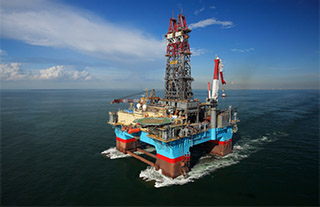(Bloomberg) -- Exxon Mobil Corp. scaled back production targets and said drilling budgets will continue to drop through the end of next year as the oil market shows no signs of a recovery.
Exxon said output from its 45,000 wells will hover at the equivalent of 4 million to 4.2 million barrels a day through 2020, rather than hitting the old target of 4.3 million as soon as next year, Chairman and Chief Executive Officer Rex Tillerson told analysts at the company’s annual strategy session in New York on Wednesday. Capital spending will fall about 25% this year to $23.2 billion and will decline again in 2017 because it makes no sense to drill money-losing wells at current prices, he said.
“We’re still oversupplying a market that doesn’t need it, doesn’t want it,” Tillerson told analysts at the New York Stock Exchange on Wednesday. “Global economic conditions are not inspiring. I don’t think we can look to the demand side of this market to solve this problem for us.”
The glut-driven tumble in stock prices across the industry hasn’t led to a wave of takeovers because many oil explorers have been piling on debt or issuing new shares to stay afloat, making them much less attractive to potential suitors, Tillerson said. For that reason, Exxon has focused on buying individual assets rather than entire corporations, he said.
Fewer Deals
The growing balance-sheet complexity of smaller companies that are struggling to survive probably means their assets will only come up for sale once they’ve filed for bankruptcy, he said.
Despite the bleak outlook for crude supply and demand, Exxon is under no pressure to resort to asset sales to raise cash, Tillerson said. Competitors who advertise how much money they intend to raise through asset sales are “foolish” and “destroying value,” he said.
“We are not event-driven,” Tillerson said. “This approach avoids forced sales at the wrong point in the cycle.”
For Tillerson, an Exxon lifer in his 11th year as CEO, Wednesday’s event may be among his final chances to publicly represent a company with annual sales that dwarf most of the world’s national economies. He turns 64 this month, one year shy of Exxon’s mandatory retirement age. The board elevated former refining boss Darren Woods to president in December, signaling he is in line to succeed Tillerson as CEO.
Bond Sale
The $12 billion the company raised this week through bond sales will be used to fund oil and gas projects that will generate returns times higher than the costs of borrowing that capital, he said. The debt will not be used to pay dividends, which Exxon plans to cover with cash flow, he said.
“Our focus will remain making choices that enhance shareholder value,” Tillerson said. “We’re not going to borrow money to cut someone a check.”
Exxon and the rest of the oil industry haven’t been able to trim costs as quickly as crude prices have plummeted. Exxon’s production costs averaged $10.56 per barrel last year, down from $12.55 in 2014, the company said in Feb. 24 public filing. That 16% decline was outpaced by the 46% drop in worldwide crude prices over the same time span.
Every $1 drop in crude prices cuts Exxon’s annual after-tax earnings by $375 million, company data showed. Standard & Poor’s and Moody’s Investors Service both have warned they may downgrade the top credit ratings Exxon has held for decades. The rating gives Exxon an edge over rival explorers when negotiating exploration deals with oil-rich nations, Tillerson has said.
Exxon pumped the equivalent of 4.25 million barrels a day during the final three months of 2015, according to data compiled by Bloomberg.




